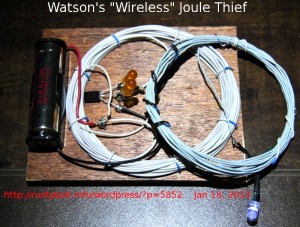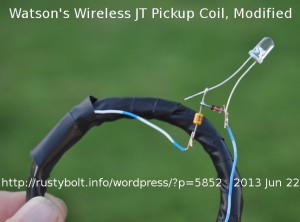 I was watching Sohei’s “wireless” light on Youtube and I decided to build a similar one. It’s not much different from the Tesla pancake coils I was experimenting with recently. This “wireless” Joule Thief is not really wireless, because it doesn’t really radiate radio frequency energy. It’s just a transformer with the secondary winding separate and independent from the primary winding, with the energy coupled electromagnetically.
I was watching Sohei’s “wireless” light on Youtube and I decided to build a similar one. It’s not much different from the Tesla pancake coils I was experimenting with recently. This “wireless” Joule Thief is not really wireless, because it doesn’t really radiate radio frequency energy. It’s just a transformer with the secondary winding separate and independent from the primary winding, with the energy coupled electromagnetically.
To make the coil, I used a hank of white wire from a ten foot parallel printer cable, and a shorter hank of wire from a six foot cable. They are both 26 AWG, and the longer one is the primary (collector) winding and is about 23 uH and 0.232 ohm DC resistance. The shorter one is the feedback (base) winding and is about 13 uH. They’re just put together and tied down to the piece of plywood with some short lengths of wire. The inside diameter is 2.8 inches or 70mm. The secondary (LED) winding is about 22 uH but it looks thinner, maybe 28 AWG white wire and is 0.345 ohm DC resistance. The LED is just soldered to its ends. The other parts are soldered to the heads of small screws that I put into the plywood at various locations.
The transistor is a 2SC2500D, which is really hard on the AA cell. The resistor is the standard 1k, 5%, 1/4 watt resistor. The two amber LEDs are in series and are connected between emitter and base with the cathodes toward the base. They prevent the base voltage from going more negative than 6 volts, and you can see they are glowing slightly, showing that the base voltage is going down to negative 6 volts.
The circuit draws 400 mA from the 1.5v supply, and the AA cell doesn’t last very long. The 2SC2500D is a very high gain power hungry transistor and sucks a lot of current. I could reduce it by increasing the value of the resistor. The white LED is not lit very bright because the secondary coil is not centered over the primary. When I put it directly over the primary the LED gets much brighter. But the LED is polarity sensitive: if I flip the coil over, the LED is much dimmer. I think this coil needs some more turns; the LED is not as bright as it could be, considering all the current that the circuit is drawing from the AA cell. I’m going to experiment with this coil some more. I have also placed the chokes from the pancake coil inside of this coil and the LEDs light up.
Update Jan 19 – I changed the secondary to a coil having a much longer wire, It measured 0.625 ohm and 56 uH. The LED lights up much brighter, and is beginning to act like a flashlight or light, as Sohei showed in his video.
 Update Jun 22, 2013 – I added a half wave voltage doubler to the picjup coil between one of the coil wires and the anode of the LED. But the LED serves as the second diode, and there is no filter capacitor. This arrangement reduces the loss and helps the LED when the pulses are negative going, since it captures the negative going pulses. I used a 0.1 uF capacitor between the coil wire and the diode, which was a 1N4148.
Update Jun 22, 2013 – I added a half wave voltage doubler to the picjup coil between one of the coil wires and the anode of the LED. But the LED serves as the second diode, and there is no filter capacitor. This arrangement reduces the loss and helps the LED when the pulses are negative going, since it captures the negative going pulses. I used a 0.1 uF capacitor between the coil wire and the diode, which was a 1N4148.